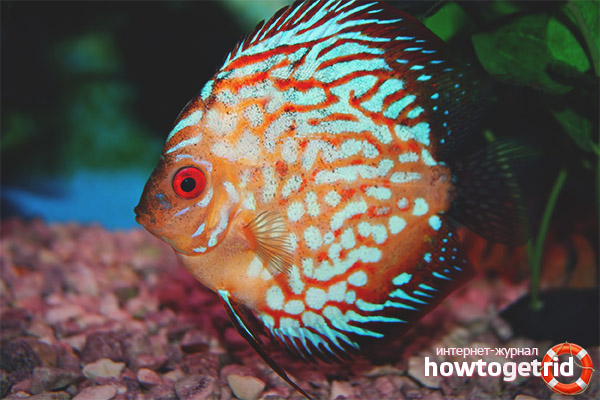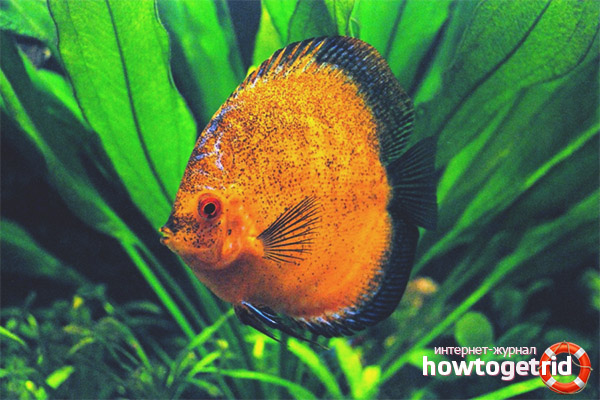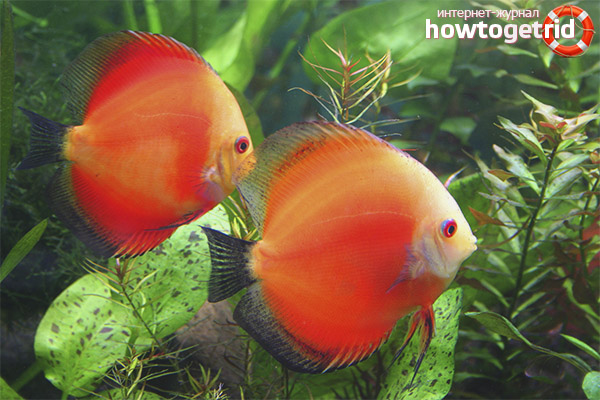The content of the article
The aquarium discus fish has an original body shape, as well as a very beautiful color. Fans of aquariums call them real kings among other inhabitants of the freshwater aquarium. These fish are quite large, have a bright color. Representatives of the species can have many colors. They behave measuredly and majestically, as befits a real royal person. They have a peaceful character and special elegance, due to which they stand out among other fish and always attract the eye of the observer.
Discus belongs to cichlids. There are three subspecies of these fish. Two varieties have been known to aquarists for a long time, and one of them was discovered recently. Two long-known subspecies are Symphysodon aequifasciatus, as well as Symphysodon discus. They are the most popular. Their natural habitat is the middle and lower parts of the Amazon. These varieties are similar to each other. They have a similar color and behave similarly. The third variety has the Latin name Symphysodon haraldi. This fish is called the blue discus. The subspecies was described by Heiko Bleher. But today it is awaiting confirmation.
Today, wild varieties of discus are found in nature much less often than artificial ones. Derived forms have a very interesting color. But they have many shortcomings. They do not adapt well to the conditions of the aquarium, they are more sick, it is necessary to care for them more carefully and carefully. Discus fish are expensive. Not only their purchase, but also the content is expensive. Among all aquarium fish, they are among the most demanding of conditions. Water parameters for discus should be constantly at the required level. The aquarium should be spacious, and the food plentiful and high quality. Therefore, when acquiring a discus, you need to think about whether you have enough experience in maintaining the aquarium, whether you will find the means and time to properly care for them.
Living in nature
These fish come from South America. These are countries such as Peru, Brazil and Colombia. Discus live both in the Amazon itself and in its tributaries. In the 30s, representatives of this species first appeared in Europe. Earlier they tried to bring them to Europe, but the attempts were unsuccessful. Given the previous bad experience, this was still possible. Today in nature you can find green, red and blue representatives. Let us consider in more detail each variety of this fish.
- The green discus, whose name in Latin sounds like Symphysodon aequifasciatus, was described in 1904 by the scientist Pellegrin. Representatives of the subspecies can be found in the central part of the Amazon. They live in the Putumayo River in Peru, as well as in Lake Tefe, which is located in Brazil.
- The red discus is also called the Heckel discus. In Latin, the subspecies is called Symphysodon discus. John Hekkel described these fish. Records date back to 1840. These fish live in Rio Negro, flowing through Brazil.
- Scientists call the blue discus Symphysodon haraldi. Schultz described it back in 1960. Their habitat is the lower part of the Amazon. Subspecies discovered recently.
Description
These fish are quite large in size. Their body is disc-shaped. Moreover, depending on the subspecies, it can be about 15-25 cm in length. These cichlids are one of the most flattened in comparison with their other relatives. These fish got their name precisely because of their disc-shaped form.
To date, a lot of artificial varieties of discus have been developed, which differ in a wide variety of colors. Therefore, one cannot say what color these fish have. Enumerate options can be very long. The most common colors are leopard, red, yellow, turkis and many others.
But as a result of crossing the fish with new colors, they also acquired quite poor health. Their immunity is low, so they often get sick. Wild discus is more resistant to disease and changing external conditions, but in aquariums they can be found less and less.
Content Issues

Acquiring discus is recommended for those aquarists who have already gained considerable experience. Beginners should not buy them. Moreover, the fish is not cheap, and it will be very unfortunate if it dies. Discus care will be a challenge even for experienced aquarium enthusiasts. It is quite difficult to provide them with the conditions that they need. And the breeding of such fish does require a lot of experience and knowledge.
As soon as the aquarist acquires such a fish, he is faced with the problem of acclimatization. Adults can get used to changing their habitat faster and easier, but even they are stressed.
The problems are also caused by the large size of fish, weak immunity, high requirements for conditions and quality of food. In addition, these fish need to keep the water always warm. Before you purchase such fish, you need to study all their requirements and prepare to maintain the necessary conditions. It is necessary to purchase a large volume aquarium, a powerful high-quality filter, and high-quality feed. Even with everything you need, you will first have to be patient.
When buying and transporting, be careful. They may get decoy or some other illness due to being stressed during the move.
Feeding
The main diet of the discus should be animal feed. It can be live or frozen. A pipe maker, artemia, gammarus will suit them. But many aquarists feed their discus with a special food designed for fish of this species or minced meat, which includes many components. It should be minced seafood, beef heart, various vegetables and a complex of vitamins. Everyone who has considerable experience in maintaining such fish has developed their own feeding recipe, which often includes more than 10 components.
In addition, it is important not to forget that these fish are shy and slow. If they are kept together with other fish, they may not have time to eat food. Therefore, it is desirable to contain them separately.
It should also be borne in mind that from protein feed there is waste that deteriorates and causes an increase in the amount of harmful substances in the water, which is unacceptable for discus. To avoid the accumulation of harmful substances, the bottom must be siphoned regularly. But many experienced aquarists simply do not use any soil.
Live food can cause fish poisoning or illness. Therefore, they are fed more often with minced meat or ready-made purchased food.
Content
To contain the discus, you must purchase an aquarium of at least 250 liters. When buying not one, but several such fish, its volume should be 300-400 or more liters. It is important that he is tall. Be sure to use a strong filter, constantly siphon the soil and replace the water. It is important that the water is very clean, without ammonia, nitrates. Parameters must be strictly at the proper level.
Fishes leave behind not so much food waste, but due to the fact that their food is protein, it quickly decomposes and begins to pollute the water.
Discus like water to be acidified, soft. The temperature you need is very warm. Water should be warmer than for many tropical fish.This is a problem due to which it is extremely difficult to find neighbors for these fish.
In order for the discus to feel good, the water temperature should be 28-31 degrees. Water hardness is 10 -15, and pH is 6-6.5. If the parameters go beyond this, it will lead to illness or death of the fish.
These fish love peace and are shy. Loud sound, constant movement or blows to the aquarium will be a real stress for them. It is also impossible to lodge too active neighbors with them. Therefore, the aquarium should be in the most peaceful place.
You can plant plants in the aquarium with these fish. But it is important that they still have a place for swimming. Suitable plants are difficult to pick up, as many of them will not grow at such a high temperature. You can plant didiplis, ambulia or wallisneria. But these fish are valuable and look good without any decor or vegetation. Professionals do not plant plants in discus aquariums, and also do not use soil and decor. This simplifies care and reduces the possibility of disease.
Having launched the discus into the aquarium after the acquisition, you can not disturb it for some time. Do not immediately turn on the light and stand near the aquarium. The fish should get away from stress and get used to it. It is advisable to put in the aquarium any object that can serve as a shelter for it. Someone might be surprised why people buy such complicated and fastidious fish. But those who will take care of them properly will receive a lot of pleasure as a reward.
Compatibility
These fish are quite peaceful, which distinguishes them from most cichlids. They will not dig the ground or hunt neighbors. Prefer to live in flocks. Alone, they will feel uncomfortable.
It’s difficult to choose neighbors for them. After all, they eat rather slowly and love the very high temperature of the water.
It is because of this that most often they are kept separately. But you can pick up neighbors. It can be neons, Congo, taracatums. You can not add to them catfish having a suction cup instead of a mouth. Corridors are also not suitable as neighbors, as they are carriers of parasites.
Gender differences
Determining gender is not easy. You can only say for sure during the spawning season. But experienced lovers claim that males have a steep forehead, and their lips are thicker than females.
Breeding
The female usually lays eggs on decoration elements or plants. Today you can purchase a cone that is easy to use. Spawning can occur in fairly hard water. But for the fertilization of eggs, this indicator should be maintained at a level no higher than 6. The pH level should be about 5.5-6. Temperature - 28-31.
Several hundred eggs are laid at a time. After 2.5 days they will hatch. When the fry appear, during the first few days of their life they will have a special secret that the skin of their parents releases.
Video: aquarium fish discus












Submit